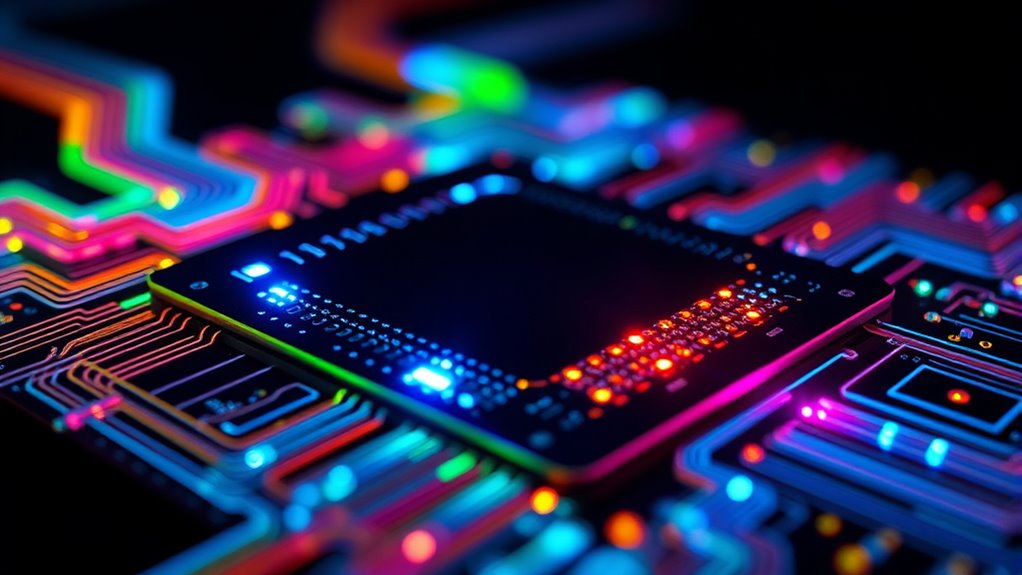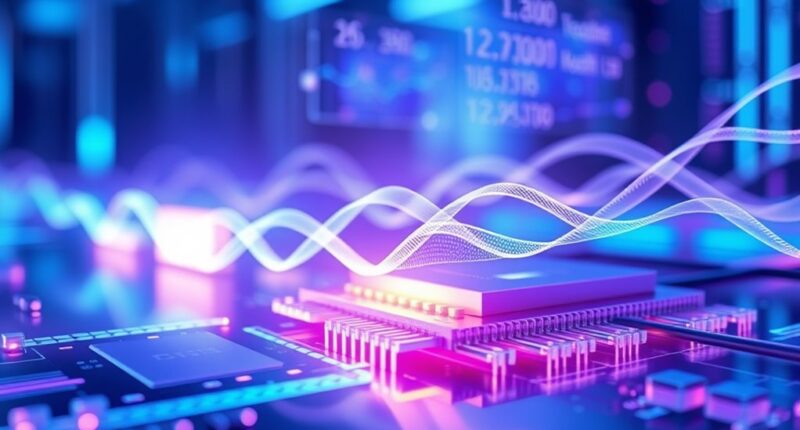Optical computing has the potential to cut AI’s energy demands by up to 99% by using photons instead of electrons for data processing. This technology enables faster, more efficient data transfer and reduces the energy needed for computations considerably. As chips and systems become fully optical, energy consumption drops, helping address the growing global energy crisis. If you want to understand how this breakthrough can transform AI, keep exploring the possibilities ahead.
Key Takeaways
- Optical computing uses photons instead of electrons, significantly increasing processing efficiency and reducing energy consumption in AI systems.
- Fully optical processors eliminate the need for light-electrical conversions, minimizing energy loss and boosting overall efficiency.
- Photonic technology enables high-speed, high-frequency AI processing, decreasing the energy required for complex computations.
- Industry advancements in optical interconnects and materials aim to scale optical computing for large AI workloads.
- Implementing optical computing in data centers could cut AI energy demands by up to 99%, addressing sustainability and global energy concerns.

Have you ever wondered how the rapid growth of artificial intelligence is impacting energy consumption? As AI becomes more complex and widespread, its energy demands skyrocket, putting pressure on existing infrastructure and raising sustainability concerns. Traditional electronic computing methods are reaching their limits, prompting researchers to explore innovative solutions like optical computing. This technology uses light—photons—rather than electrons to perform calculations, offering a promising way to dramatically reduce energy consumption. Photonics enables data to be processed and transmitted with much higher efficiency, especially in data centers and AI tasks that require intensive computation.
One of the biggest advantages of optical computing is its potential for energy efficiency. By replacing electrons with photons, you increase the efficiency by up to ten times. This means that vast amounts of data can be processed using notably less power. Additionally, optical computing provides bandwidth improvements of 10 to 50 times over traditional systems, enabling faster data transfer and processing speeds. This speed boost is vital for AI applications, where rapid computation can make a big difference, especially in real-time tasks like image recognition, natural language processing, and complex simulations. The scalability of photonic technology means it can be integrated into larger electronic systems, paving the way for more energy-efficient, high-performance AI hardware. Photonic systems are also capable of operating at higher frequencies, further enhancing their suitability for high-speed AI processing. Music therapy can also enhance emotional well-being, benefiting those working in high-stress AI environments.
However, challenges remain. Current chip designs are mostly two-dimensional, which limits performance and scalability. Signal loss during inter-chip communication can also be a problem, reducing efficiency. Moreover, photonic chips cannot store data optically, forcing conversions between light and electrical signals that slow down processing and consume additional energy. Noise and signal weakening in large optical circuits pose further hurdles, as they can compromise accuracy and reliability. Despite these issues, innovations in optical interconnects are helping to mitigate some of these limitations. Using light to transfer data between electronic components reduces signal loss, and new materials like lithium niobate improve the precision and performance of optical devices.
The future of optical computing in AI looks promising. Fully optical processors could eliminate the conversion penalties that currently hamper performance, while fiber optic systems can perform complex calculations efficiently. Industry efforts are increasingly focused on commercializing these technologies, especially in data centers, where energy consumption is projected to rise sharply. Photonics can reduce data center energy use by over 50% by 2035, helping to address the growing energy crisis driven by AI. Photonic processors are already demonstrating their ability to perform specific AI tasks, like convolution operations and machine learning computations, faster and more efficiently than electronic counterparts. If these innovations progress, optical computing could slash AI’s energy demands by up to 99%, transforming how we power the future of artificial intelligence.
Frequently Asked Questions
How Soon Could Optical Computing Become Commercially Available?
Optical computing could become commercially available by the mid-2030s if current advancements continue. You should expect ongoing progress in materials, chip design, and data transfer technologies, which are essential for scaling up. While challenges remain, increased investments and research in silicon photonics and quantum photonics are accelerating development. Stay informed, as breakthroughs and infrastructure improvements could bring practical optical computing products within your reach sooner than you think.
What Are the Main Challenges in Integrating Optical Tech With AI Systems?
You face major hurdles integrating optical tech with AI systems, mainly due to low memory density, efficiency issues, and signal conversion losses. You’re also challenged by difficulties in scaling and connecting different optical components seamlessly. Additionally, calibration, manufacturing precision, and the need for hybrid electronic-optical systems create complexity. Overcoming these barriers requires breakthroughs in optical memory, system integration, and fully optical processing, which are still in development stages.
Will Optical Computing Replace Silicon-Based Processors Entirely?
You might wonder if optical computing will fully replace silicon processors someday. The truth is, it’s unlikely anytime soon. While optical tech promises incredible speed and efficiency, significant technical, manufacturing, and software hurdles remain. Instead, you’ll see hybrid systems that combine both technologies, gradually enhancing performance. So, don’t expect a complete switch overnight — the future will probably be a blend, evolving step by step.
How Does Optical Computing Impact AI Training Times?
Optical computing drastically reduces AI training times by enabling massive parallelism and ultralow latency. You’ll experience faster training cycles because light-based systems perform many calculations simultaneously, bypassing the bottlenecks of traditional digital processors. With optical matrix multiplications happening in nanoseconds and high throughput, your models train more quickly, allowing you to iterate and improve AI performance faster than ever before.
Are There Environmental Benefits Beyond Energy Savings?
Think of optical computing as a gust of fresh air for the environment. Beyond energy savings, it reduces water use by cutting cooling needs, alleviating stress on water supplies and ecosystems. It also extends hardware lifespan, lowering e-waste and resource extraction impacts. Plus, its enhanced security minimizes unnecessary data processing. These benefits create a ripple effect, helping to protect ecosystems, conserve resources, and promote a more sustainable tech future.
Conclusion
So, next time your AI is choking on energy bills, just remember—optical computing could cut its power needs by 99%. Imagine a world where AI doesn’t drain the planet or your wallet. Who knew that simply switching to light-speed tech could save humanity from itself? It’s almost as if we’re choosing between a sustainable future and powering a sci-fi nightmare. Funny how simple solutions can be the most revolutionary, isn’t it?









